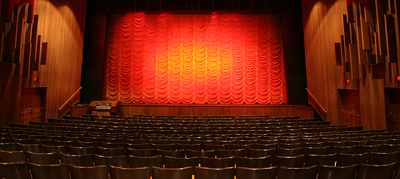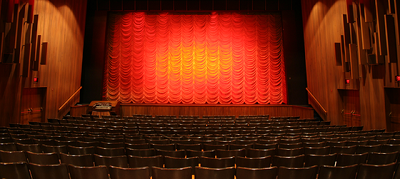It was a basement room occupied by a scattering of mostly silent people staring at a blank wall. Could I really be at New York’s Museum of Modern Art instead of out in the daylight having lunch with friends from work? Emphatically yes, as the lights dimmed and the wall transformed into a silver screen onto which were projected some of the best movies ever made. The next 90 minutes would be an enjoyable schooling in the art of film, and learning how the Nickelodeon tradition from the turn of the 20th century transformed into one of the greatest art forms (when done right) ever known.
 Leo S. Bing Theater at LACMA
Leo S. Bing Theater at LACMA
I was in a museum with art upstairs and film downstairs: galleries and a screening room. This was my introduction to that convergence of forms that today is universally recognized by anyone that understands the inseparability of these two artistic disciplines. Art and film are no longer tied to their separate venues of museum and movie house, but can share collective space at museums like MoMA and LACMA.
I was lucky to get this awareness as a young teenager with a summer job, around the corner from MoMA. My luck doubled when I discovered that the student-membership card to the museum to participate in the film program also allowed me entry into the galleries.
I never would have thought of becoming a museum member if it were not for the film program. School trips to the Met and the Hayden Planetarium, the Natural History Museum, and the Cloisters formed my knowledge base about museums. Even with that, I was mostly ignorant about art except for a few favorite pieces in the Met, and everything at Fort Tyron Park, where the collection of medieval armor at the Cloisters riveted my attention.
As a teenager, I got to show my membership card and return to MoMA’s basement repeatedly during the summer, and to have etched into my consciousness the lasting impression of positive images sunk into the negative space of a mind that never considered movies as cinema or even film, let alone art, but as a way to have fun with friends at Saturday afternoon double features.
Alone, but not all alone, in the dark. Free of outside influences. Mesmerized. Hungered. Stimulated by sights and sounds that made history. Narcotized by unstable nitrate films that could have only two possible paths: to dissolve or even explode, and to be stolen from culture that way, or be preserved by philanthropists or filmmakers like Martin Scorsese that understood the importance of preventing the theft of film from the world of art. Forgetting nothing. Preserving those images as a series of unsprocketed flickers across the screen of my memory. Learning that film was art.
Discovering Murnau's silent masterpiece Sunrise that still haunts decades later, never setting in my mind. Witnessing Jimmy Cagney in White Heat shout “top of the world, Ma!” as he was executed, or being frightened by the train coming straight off the screen at me in The Great Train Robbery that, in 1903, was the first movie that told a story driven by narrative and became an important historical point in the evolution of the art form. Learning that Thomas Edison invented more than the light bulb. Watching Wings, the movie that won the first Academy Award ever given by the newly formed Academy of Motion Picture Arts and Sciences for Best Picture of the year. Another historical first. Hearing cracking voices of silent stars that tried to transition to talkies, but failed. Douglas Fairbanks and Mary Pickford among those casualties. Discovering new stars that moved me with their words. Learning that Norma Shearer made the transition from silents to talkies through the skillful intercession of her MGM sound department-manager husband Douglas that tweaked her voice recording just enough to make her one of the few stars of both silent and sound films.
Later my movie-film-cinema-art education moved from that basement screening room at MoMA to the Walter Reade and Dan Talbot venues that were some of the premiere art houses in the country, where the French auteur New Wave was shown when it was really new, and was the first time I heard art and film mentioned in the same phrase. After that, a click to the next generation and the phenomena of expanded cinema involving artists like Hans Richter who was an artist that influenced film.
Over the years, not only at MoMA but at LACMA, where I was drawn to the Ron Haver–curated film program in the Bing Theater, and Filmex, the singular film festival organized by what were popularly called the two Garys: Esert and Abrams, my love of movies morphed into a love of art, made seamless because one venue provided both creative expressions.
The best kind of twofer: art and film that intersected unexpectedly in my life and became a template for me and many others who love both of these expressions of creativity, that could drive a convergence that has empowered museums to expand their collections and programming and curatorial interests to include what had once been derided as the flickers.
It all started for me in that museum basement and in those galleries. At an art museum that imprinted the coexistence of art and film onto my mind. Founded and funded by philanthropic Rockefellers, exhibiting the works of early explorers in the art of mixing light and motion, kinetically presenting themes that were otherwise displayed one dimensionally on gallery walls a few floors above. A convergence of art and film that decades later is taken seriously by museums and philanthropists, preservationists and scholars to the benefit of all to enjoy art and film together.
Tim Deegan, director of guest services, public engagement



